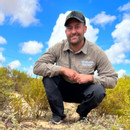Highlights from our 2024 Herpetology Tours

Operations Manager & Tour Leader
18th June 2024
Naturetrek offers the world’s largest selection of expert-led herpetology-focused holidays and our tours take participants through beautiful habitats in search of the planet’s most incredible and sought-after reptile and amphibian species. This year, we have once again enjoyed great success in introducing clients to fascinating reptiles and amphibians around the world. These tours support conservation projects and in-country biologists who are working to protect wildlife, in particular threatened reptiles and amphibians. In this article, we share the highlights from the tours.
We welcome participants of all levels of experience onto these holidays – being a keen naturalist is the only requirement – do join us in 2025 and 2026!
NB: All photos shown below were taken during the tours. To view the images larger, please click on the crosshairs in the centre of each image.
February's 'Reptiles & Amphibians of Ecuador' holiday was a resounding success, with Planet Earth III hero Jaime Culebras guiding participants to enjoy a spectacular range of over 135 different herp species! Highlights included Pinocchio and Banded Tree Anoles, Tropical Thornytail Iguana, Rainbow Boa, Variable Poison Frog, White-lined Monkey Frog, Maria Elena's Glass Frog, Ecuadorian Climbing Salamander, Red-eyed Woodlizard, Tropical Flatsnake, Blunt-headed Treesnake, Two-striped Forest-pitviper, Osborne's Lancehead and Black Caiman.
The itinerary visited the ‘Naturetrek Reserve’ in the Río Pastaza valley, where we found Blue-spotted Dwarf-iguana, Yellow-throated Stream-lizard, Santa Rosa Robber Frog and a wealth of beautiful tropical flora. The superb Napo Wildlife Centre provided the opportunity to watch a bevy of Giant River Otters hunting as a family and the privilege of psittaciform-watching at an active clay lick, their stage briefly interrupted by a Lowland Paca. At either end of the holiday, the cloudforests of Mindo and Guango rounded off a simply wonderful tour. Highlights across the other taxa included an Andean Cock-of-the-rock lek delivering a performance of more than 10 males, Blue-and-yellow and Scarlet Macaws, Ferruginous Pygmy Owl, Paradise Tanager, Toucan Barbet, Great Potoo, charms and charms of hummingbirds, Napo Sako Monkey, Kinkajou, opossums and much more.
Joining in-country partners who are carrying out vital research into the status of range-restricted vipers in Kenya, participants on this tour were unequivocally in agreement about their highlights of our ‘Reptiles & Amphibians of Kenya’ tour in March: seeing some of the world’s most sought-after vipers in Hairy Bush, Green Bush, Kenya Montane and Rhinoceros.
With local guide Dickson’s unrivalled eyesight and skill at locating cryptic species, the group were able to find and photograph several rarely-seen chameleons including Kenya Pygmy, Boulenger’s Pygmy, Flap-necked, Mount Kenya Hornless, Side-striped, Jackson's, the breathtakingly exquisite Mount Kenya Side-striped, and High-casqued. Of the latter, we recorded 83 individuals in a single evening!
Other herp highlights included Boomslang, Usambara Vine Snake, Speckled Green Snake, a juvenile Short-necked Skink, Rainbow Skink, Mount Kenya Alpine-meadow Lizard, White-throated and Nile Monitor Lizards, Mackay’s Forest Tree Frog, Loveridge’s Snouted Toad, Red-banded Rubber Frog, Edible Bullfrog and much more.
The huge list of other highlights included Eastern Black-and-white Colobus Monkeys, Gerenuk, African Palm Civet, Kenya Coast Galago, White and Black Rhinoceroses, Savanna Elephant, Spotted Hyena, Golden-rumped Elephant Shrew, Forest Giant Squirrel, Great Blue Turaco, Pygmy Falcon, African Crowned and Martial Eagles, African Hawk Eagle, Marabou, Saddle-billed and African Woolly-necked Storks, Secretary Bird, Grey Crowned Crane, Dwarf Bittern, Lühder's Bushshrike, Golden-breasted Starling, Black-tipped Diadem, Green-banded and Central Emperor Swallowtails, Flying Handkerchief, Savannah Charaxes, Cabbage Tree Emperor and much more.
In April, licensed experts from our partners Amphibian and Reptile Conservation Trust (ARC) led participants to views of no less than 17 Sand Lizards, 15 Common Lizards, eight Slow Worms, two Smooth Snakes, Adder and Grass Snake. The amphibians included Great Crested Newt, Smooth Newt and a memorable night with six Natterjack Toads backlit by the moon at the coast.
The other highlights included Brown Long-eared, Noctule and Daubenton’s Bats, Dartford Warbler, Western Marsh Harrier, Tawny Owl, Ruby Tiger, Dor Beetle and Bloody-nosed Beetle. Back at our base, the wonderful Mortons Manor, a Grade II listed Elizabethan manor house sitting at the base of Corfe Castle, the group enjoyed an informative talk by Gary Powell, Reserve Manager at ARC, about the organisation and the vital work they do.
For our 6th and 7th Moroccan herpetology tours since 2022, one group tour and one tailormade tour journeyed through the unique habitats of southern Morocco, staying at authentic accommodation throughout.
Highlights across the two tours included Moorish Diadem Snake, Maghreb Fan-fingered Gecko, North-east African Carpet Viper, Sahara Sand Viper, Dumeril's Wedge-snouted Skink, False Smooth Snake (of the Atlantic Sahara morphotype), Mediterranean Chameleon, Golden Fringe-fingered Lizard, Moroccan Day Gecko, Algerian Hedgehog, Red-necked Nightjar, Rufous-tailed Scrub Robin, Northern Bald Ibis, Moussier's Redstart, and more.
The tailormade tour included our superb High Atlas Mountain extension, where highlights included Mountain Viper, Atlas Day Gecko, Moroccan Painted Frog, Mountain Skink, Stripeless Treefrog, Mole Cricket, female European Black Widow and Seebohm's Wheatear. At our lovely mountain accommodation, a nightingale serenaded the valley every couple of minutes as the group went to sleep.
In May, Albanian herpetologist and popular Naturetrek leader Dr. Enerit Sacdanaku guided participants across his home country. The undoubted highlight for all – including Enerit – was finding one of Europe’s rarest vertebrates in the Greek Meadow Viper. The moment will be etched into the memory of all the group, finding such a species in special mountain scenery. The other highlights included Nose-horned Viper (both montandoni and ammodytes subspecies), Aesculapian Snake, Dahl's Whip Snake, Eurasian Worm Snake, Dalmatian Algyroides, Albanian Pool Frog, Yellow-bellied Toad and numerous others.
Other highlights included Black-headed and Cirl Buntings, Tree Sparrow, Red-backed Shrike, a large colony of Alpine Swifts, Large Copper, Glanville, Spotted and Queen of Spain Fritillaries, Southern and Eastern Festoons and Nettle-tree Butterfly.



 Loading search...
Loading search...





























